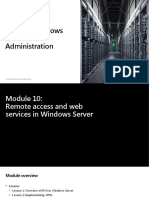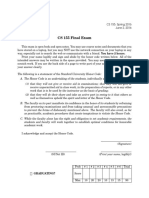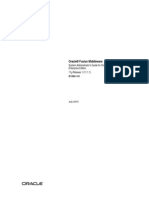HTTP Authentication
HTTP Authentication
Uploaded by
Aurelia ArnăutuCopyright:
Available Formats
HTTP Authentication
HTTP Authentication
Uploaded by
Aurelia ArnăutuCopyright
Available Formats
Share this document
Did you find this document useful?
Is this content inappropriate?
Copyright:
Available Formats
HTTP Authentication
HTTP Authentication
Uploaded by
Aurelia ArnăutuCopyright:
Available Formats
Frank Fiedler, frank.fiedler@student.fh-nuernberg.
de, Matrikelnummer: 670530
HTTP Authentication: Basic and Digest Access Authentication RFC 2617 Obsoletes RFC 2069
Table of Contents Positioning at the Internet Layer Basic Access Authentication Digest Access Authentication Proxy-Authentication and Proxy-Authorization Security Considerations
Positioning at the Internet Layer: HTTP-Authentication is part of the HTTP-Protocol. The HTTP-Protocol is positioned at Layer 5/Layer 6. Overview / Purpose HTTP Authentication wants to provide a build in mechanism for requiring a valid username/password to gain access to web recourses. HTTP Authentication is initiated by the web server or an external cgi-script There are currently 2 modes of authentication built into HTTP 1.1 protocol, termed Basic and Digest Access Authentication. Basic Access Authentication: Example: The HTTP-Header of a standard client requests on some Document in a protected Area: GET /download/report.doc HTTP/1.1 Accept: application/msword, */* Accept-Language: en-us Accept-Encoding: gzip, deflate User-Agent: Mozilla/4.0 (compatible; MSIE 5.01; Windows NT 5.0) Host: 10.0.0.5:81 Connection: Keep-Alive Server reads configuration files and determines that resource falls within a protected directory. Server can only allow access to known users.
Server Sends HTTP 401 Authorization Required Response Error: HTTP/1.1 401 Authorization Required Date: Tue, 22 Jun 2004 03:54:06 GMT Server: Apache/1.3.29 (Unix) WWW-Authenticate: Basic realm="Protected" Keep-Alive: timeout=15, max=100 Connection: Keep-Alive Transfer-Encoding: chunked Content-Type: text/html; charset=iso-8859-1 Now the Browser displays Username/Password prompt displaying host name and authentication realm. If the User hits the cancel-Button of this Dialog the HTTP 401 Authorization Required Response Error page send together with the HTTP 401 Authorization Required Response will be shown. If the User enters an Username/Password: the Client Resubmits Request with Username/Password: GET /download/report.doc HTTP/1.1 Accept: application/msword, */* Accept-Language: en-us Accept-Encoding: gzip, deflate User-Agent: Mozilla/4.0 (compatible; MSIE 5.01; Windows NT 5.0) Host: 10.0.0.5:81 Connection: Keep-Alive Authorization: Basic ZnJhbms6ZmllZGxlcg== Server compares client information to its user/password list: - username : password is valid: server sends requested content. - authorization fails: server resends 401 Authorization Required header - Client hits cancel: browser shows error message sent along with 401 message. The problem with Basic Access Authentication is that the Username/Password is sent in clear text: Authorization: Basic ZnJhbms6ZmllZGxlcg== is just the Base64 encoded username/password pair entered by the User in clear text. "ZnJhbms6ZmllZGxlcg==" base64decode() "frank:fiedler"
Digest Access Authentication: A possible solution of this problem is offered by the Digest Access Authentication. Password won't be sent in clear text. The password will be sent encrypted (normally as md5 hash of the password and some other values) Therefore some additional Headers are required: Server requests Authorisation: HTTP/1.1 401 Unauthorized WWW-Authenticate: Digest realm="Protected", qop="auth,auth-int", nonce="dcd98b7102dd2f0e8b11d0f600bfb0c093", opaque="5ccc069c403ebaf9f0171e9517f40e41" Description of the additional attributes realm: Displayed to User in Login-Formula (like at Basic Access Authentication) qop: quality of protection Is required for backward compatibility with RFC 2069 - The value "auth" indicates authentication; - The value "auth-int" indicates authentication with integrity protection. Therefore the Hash value is calculated over the whole entity-body. nonce: server-specified quoted data string uniquely generated each time a 401 response is made. It will be used for the encryption of the username/password pair. opaque: quoted data string replied unchanged the whole session by the client; it might be used for example for session tracking by the web server. This field is optional. stale: flag set if the client or the server requests a new nonce value TRUE: - if the client wants to reauthenticate - if the server gets an outdated nonce value but correct user/password from the client calculated with this outdated nonce value algorithm: one or more algorithms used to encrypt user/password. Normally MD5 is used to encrypt the username/password pair within the Digest Access Authentication. The nonce value and the opaque value are sent in hexadecimal notation.
Client replies Authorisation: Authorization: Digest username="frank", realm="Protected", nonce="dcd98b7102dd2f0e8b11d0f600bfb0c093", uri="/dir/index.html", qop=auth, nc=00000001, cnonce="0a4f113b", response="6629fae49393a05397450978507c4ef1", opaque="5ccc069c403ebaf9f0171e9517f40e41" Description of the additional attributes username: the username in clear text realm: the realm the user wants to authenticate to qop: the quality of protection selected by the client - must be present if the server sent a qop directive cnonce: client generated unique data string - must be present if qop is present nc: nonce-count - the count of requests sent by the client - must be present if qop is present. The nonce-count is used to avoid reply-attacks. response: the encrypted password
How the response is encrypted Depending on quality of protection its a Hash value of various attributes: If quality of protection is auth and the Algorithm is MD5 the response will be calculated this way: The Response is the MD5 Hash value of various Attribute values are merged to a long String value separated by colons: Response = MD5( username-value:realm-value:password:noncevalue:nc-value:cnonce-value:qop-value:request-methodvalue:digest-uri-value ) Proxy-Authentication and Proxy-Authorization This authentication scheme may also be used for authenticating users to proxies, proxies to proxies, or proxies to origin servers by use of the Proxy-Authenticate and Proxy-Authorization headers.
Just replace the Authentication-Header: HTTP/1.1 401 Unauthorized WWW-Authenticate: Digest ... would be at the Proxy Authentication: HTTP/1.1 407 Proxy Authentication Required Proxy-Authenticate: Digest ...
Security Considerations Basic Authentication is very insecure because of clear text transition of username/password (vulnerable to man in the middle attacks or Network sniffering) Digest Authentication: Replay attacks: The vulnerability depends on the way the nonce-value is created. It can be completely avoided (if necessary) if each nonce-value is only used once. But this would mean a higher CPU load for the web server. Multiple Authentication Schemas: Some old Browsers may only support Basic Authentication, so if you offer both basic and digest access authentication in some cases the insecure basic access authentication would be forced by the client. Some other web browsers may choose the first offered authentication mechanism. If secure Authentication is required by the Application the web server should only offer digest Authentication. Online dictionary attacks: To avoid online dictionary attacks, the usage of "strong" passwords, not listed in any dictionary, must be forced. Man in the Middle: Remove all offered choices, replacing them with a challenge that requests only Basic authentication (may realized as http-proxy). So the attacker would receive the clear text username/password bundle from the client. To avoid this, web browsers should display the auth-mechanism. But most users dont care about these warnings given by their web clients.
Another possible Man in the Middle attack would be: - eve sends the same nonce to more clients The time to find the first password will be reduced by each client reply. If one password is known all other passwords can be decrypted This can be avoided using the cnonce-directive by the clients. So the encryption does not only depend on the nonce value created by the Server but also on the cnonce value created by the client. Another security problem is the Password-File at the Server. It must be stored at a safe location! The passwords should not be stored not as clear text. The Attacker should never be able to read this file in any way.
Conclusion If you want to provide User Authentication HTTP-Authentication using Digest Authentication is a good Replacement for Basic Authentication, but compared to modern cryptographic standards HTTP-Authentication using Digest Authentication is also a weak mechanism. Better would be any kind of Authentication using a SSL-Tunnel (HTTPS). Another Problem are weak passwords, so it is also important to force the Users to use strong passwords. Basic Authentication is very insecure, so it should only be used if no security is needed. In all other scenarios it should be replaced by Digest Authentication. The strength of Digest Authentication depends on the implementation of the creation of the nonce value.
You might also like
- OAuth 2 SimplifiedDocument12 pagesOAuth 2 SimplifiedJasmina MitrovicNo ratings yet
- MFCentral - API Integration Document - CAS v2.2Document24 pagesMFCentral - API Integration Document - CAS v2.2Ankit SheoranNo ratings yet
- C++ School ManagementDocument65 pagesC++ School ManagementChelladurai .K50% (4)
- LPI 303-200: SecurityDocument39 pagesLPI 303-200: SecurityBrahim HAMDI100% (1)
- Top 55+ Most Asked SAP MM Interview Questions and Answers (2022) - JavaTpointDocument27 pagesTop 55+ Most Asked SAP MM Interview Questions and Answers (2022) - JavaTpointRaghavendra M R100% (3)
- Common Errors in BW Related To SSLDocument24 pagesCommon Errors in BW Related To SSLKrishna Chaitanya SunkavalliNo ratings yet
- COMP.7217 AssessmentS1 - 2020 PDFDocument6 pagesCOMP.7217 AssessmentS1 - 2020 PDFnathan fitnessNo ratings yet
- BI and Analytics PDFDocument11 pagesBI and Analytics PDFPamela MandalNo ratings yet
- HTTP The Protocol Every Web Developer Must Know - Part 2Document10 pagesHTTP The Protocol Every Web Developer Must Know - Part 2David Lee100% (1)
- Digest Access Authentication: Internet Security For Embedded DevicesDocument16 pagesDigest Access Authentication: Internet Security For Embedded DevicesstojancolicNo ratings yet
- Web Security CH 2Document28 pagesWeb Security CH 21109tarishiNo ratings yet
- Ccertauth PDFDocument15 pagesCcertauth PDFsundarrdNo ratings yet
- Authenticating Your Users: BY Sana MateenDocument10 pagesAuthenticating Your Users: BY Sana MateenNuha NoorNo ratings yet
- Vulnerability Test Report: IP ScanDocument32 pagesVulnerability Test Report: IP ScanJorge FalconiNo ratings yet
- Suip - Biz: Localbitcoins Vds Donation FeedbackDocument1 pageSuip - Biz: Localbitcoins Vds Donation Feedbackryo020288No ratings yet
- Everything You Wanted To Know About OpensslDocument10 pagesEverything You Wanted To Know About OpensslnakhomNo ratings yet
- Apacheupdated 18 08 09Document30 pagesApacheupdated 18 08 09jacobsunnnyNo ratings yet
- Practical HTTP Host Header AttacksDocument5 pagesPractical HTTP Host Header AttacksSemeh ArbiNo ratings yet
- Vuln ScanDocument12 pagesVuln ScanBrijendra Pratap SinghNo ratings yet
- L10 SecurityProgrammingDocument39 pagesL10 SecurityProgrammingSankarsan ChoudhuryNo ratings yet
- Pki OpensslDocument11 pagesPki Opensslgdeepthi100% (1)
- Browser Powered Desync AttacksDocument25 pagesBrowser Powered Desync AttacksKhang Tran DuyNo ratings yet
- SSL VPN For CLNDocument29 pagesSSL VPN For CLNVJ SNGNo ratings yet
- VPN ProtocolsDocument6 pagesVPN ProtocolsGaurav SharmaNo ratings yet
- Configuringme: Configuring Wired 8021x Authentication On Windows Server 2012.pdf Wired 8021x Authentication On Windows Server 2012Document96 pagesConfiguringme: Configuring Wired 8021x Authentication On Windows Server 2012.pdf Wired 8021x Authentication On Windows Server 2012simoo2010No ratings yet
- 1705 09044 PDFDocument7 pages1705 09044 PDFtradofNo ratings yet
- DEF CON 25 - Workshop-Gabriel-Ryan-Advanced-Wireless-Attacks-Against-Enterprise-Networks PDFDocument123 pagesDEF CON 25 - Workshop-Gabriel-Ryan-Advanced-Wireless-Attacks-Against-Enterprise-Networks PDFSemir BajricNo ratings yet
- Assignment2 ISDocument4 pagesAssignment2 ISAbdul MoaidNo ratings yet
- A Survey of Web Security: Aviel D. Rubin Daniel E. Geer JRDocument8 pagesA Survey of Web Security: Aviel D. Rubin Daniel E. Geer JRNirmal Raj DeivasigamaniNo ratings yet
- Feature: Squid-In-The-Middle SSL Bump - Squid Web Cache WikiDocument4 pagesFeature: Squid-In-The-Middle SSL Bump - Squid Web Cache Wiki892pkrq4q2No ratings yet
- WS-011 Windows Server 2019 AdministrationDocument66 pagesWS-011 Windows Server 2019 AdministrationAlbert JeremyNo ratings yet
- APACHE Web Server and SSL AuthenticationDocument8 pagesAPACHE Web Server and SSL AuthenticationDJ JAMNo ratings yet
- Web ApplicationDocument47 pagesWeb ApplicationVIJAYNo ratings yet
- Description: Project 2 (20 PTS)Document3 pagesDescription: Project 2 (20 PTS)Saim HaiderNo ratings yet
- 50669Document6 pages50669Alone BoyNo ratings yet
- SSLDocument122 pagesSSLKabilan KabilNo ratings yet
- CakePHP Aggressive SecurityDocument10 pagesCakePHP Aggressive SecurityPankaj Kumar JhaNo ratings yet
- MentorDocument21 pagesMentormanele6988No ratings yet
- Database Connectivity:: Computer Science Client Database Server Commands Data-Centric Connection PoolingDocument8 pagesDatabase Connectivity:: Computer Science Client Database Server Commands Data-Centric Connection PoolingSubash PoudyalNo ratings yet
- CSC2330 Assignment 3 Problem Solving 2 T1 2024Document7 pagesCSC2330 Assignment 3 Problem Solving 2 T1 2024Sampanna AdhikariNo ratings yet
- Vcenter Server CertificatesDocument7 pagesVcenter Server Certificatesspam2258No ratings yet
- HMC Remote Console Connection Errors Using Iseries Access 5250 EmulatorsDocument4 pagesHMC Remote Console Connection Errors Using Iseries Access 5250 EmulatorsYenni MarlinNo ratings yet
- HTTP Headrer FormatDocument4 pagesHTTP Headrer FormatAnkita PujarNo ratings yet
- Chapter 2 Web SecurityDocument62 pagesChapter 2 Web Securityliyagahnug61No ratings yet
- Developer Report1 PDFDocument15 pagesDeveloper Report1 PDFanon_419123855No ratings yet
- The Implementation of COAP SecurityDocument9 pagesThe Implementation of COAP SecurityMohamed Yassine GaraliNo ratings yet
- Browser Identification For Web ApplicationsDocument16 pagesBrowser Identification For Web ApplicationsDhruv JainNo ratings yet
- 2016 FinalDocument13 pages2016 FinalMd. Asaduzzaman TaifurNo ratings yet
- Silent Bob Is SilentDocument5 pagesSilent Bob Is SilentjoeNo ratings yet
- Scan ReportDocument25 pagesScan ReportNguyễn Thanh HòaNo ratings yet
- ORACLE-BASE - NGINX - Reverse Proxy ConfigurationDocument3 pagesORACLE-BASE - NGINX - Reverse Proxy ConfigurationMohamed Fowjil Abdul Hameed100% (1)
- Support and Troubleshooting - Credentials Troubleshooting On Discovery, Service Mapping, OrchestrationDocument5 pagesSupport and Troubleshooting - Credentials Troubleshooting On Discovery, Service Mapping, OrchestrationkkuppachiNo ratings yet
- Similarly God Won't Give Problems Without SolutionsDocument43 pagesSimilarly God Won't Give Problems Without Solutionsrh_rathodNo ratings yet
- Ct8ozzl TECfDs85f0xAjw Project3av3Document16 pagesCt8ozzl TECfDs85f0xAjw Project3av3Pranay SuryaraoNo ratings yet
- CHANGESDocument130 pagesCHANGESRoy MolinaNo ratings yet
- Exam Objectives: SecurityDocument13 pagesExam Objectives: Securityeng_bahiNo ratings yet
- Oauth Starkiller 645 NchatDocument2 pagesOauth Starkiller 645 Nchattallie.tyeNo ratings yet
- Efficient Multi Server Authentication and Hybrid Authentication MethodDocument4 pagesEfficient Multi Server Authentication and Hybrid Authentication MethodIJCERT PUBLICATIONSNo ratings yet
- Crypto Unit 5 ...Document9 pagesCrypto Unit 5 ...Roshan PradhanNo ratings yet
- Web Challenge 1 Supporting MaterialDocument5 pagesWeb Challenge 1 Supporting MaterialWolf shadowNo ratings yet
- Squid WalterDocument84 pagesSquid Walterenigma29No ratings yet
- Apache Axis SecurityDocument8 pagesApache Axis SecurityAbhijit JadhavNo ratings yet
- Securing .NET Web Services with SSL: How to Protect “Data in Transit” between Client and Remote ServerFrom EverandSecuring .NET Web Services with SSL: How to Protect “Data in Transit” between Client and Remote ServerNo ratings yet
- Deploying Certificates Cisco Meeting Server: Design your certificates for CMS services and integrate with Cisco UCM Expressway and TMSFrom EverandDeploying Certificates Cisco Meeting Server: Design your certificates for CMS services and integrate with Cisco UCM Expressway and TMSNo ratings yet
- Kuldeep Joshi - NewDocument1 pageKuldeep Joshi - Newkuldeep joshiNo ratings yet
- Data Base Management SystemDocument59 pagesData Base Management SystemAnurag GoelNo ratings yet
- Day1 - Introduction To PythonDocument24 pagesDay1 - Introduction To Pythonvipul anandNo ratings yet
- Compro (New) BTJDocument36 pagesCompro (New) BTJAria WinataNo ratings yet
- Systems Integration Approaches: Dr. Amor LazzezDocument15 pagesSystems Integration Approaches: Dr. Amor LazzezArsenia DuldulaoNo ratings yet
- Oracle FMW - System Administrator's Guide For OBIEE 11gR1Document560 pagesOracle FMW - System Administrator's Guide For OBIEE 11gR1hoangthanhquocNo ratings yet
- Test Case FormatsDocument20 pagesTest Case FormatsSwapnil FulariNo ratings yet
- Contents:: ASAP Installation and AdministrationDocument21 pagesContents:: ASAP Installation and AdministrationAlexNo ratings yet
- Alert Configuration Example in PI - PO Single Stack - SAP Integration Hub PDFDocument17 pagesAlert Configuration Example in PI - PO Single Stack - SAP Integration Hub PDFSujith KumarNo ratings yet
- Work Effort - GeneralDocument3 pagesWork Effort - GeneralKui MangusNo ratings yet
- Fico Fico Xpress Optimization Xpress Optimization: Reference ManualDocument117 pagesFico Fico Xpress Optimization Xpress Optimization: Reference ManualYeimmy Julieth Cardenas MillanNo ratings yet
- Work Centers in SAP EwmDocument4 pagesWork Centers in SAP EwmArun Ravi100% (4)
- Panorama: Key Security Features ManagementDocument6 pagesPanorama: Key Security Features ManagementraroNo ratings yet
- Security AuditDocument31 pagesSecurity AuditTarang Shah100% (2)
- Authoring TestsDocument8 pagesAuthoring TestsSec AboutNo ratings yet
- Ai Resume AnalyzerDocument1 pageAi Resume AnalyzerYtubegames TechknowledgeNo ratings yet
- APO SAPAPO - mc8G THL Job Schedule in BackgroundDocument31 pagesAPO SAPAPO - mc8G THL Job Schedule in BackgroundnguyencaohuygmailNo ratings yet
- Configuring The Database Archiving Mode.Document13 pagesConfiguring The Database Archiving Mode.Snow DropNo ratings yet
- Distributed Data StoreDocument11 pagesDistributed Data StoreOjas YouNo ratings yet
- Linux MCQ Fot InterviewDocument2 pagesLinux MCQ Fot InterviewBuddhika GamageNo ratings yet
- Oracle® Business Intelligence Data Warehouse Administration ConsoleDocument24 pagesOracle® Business Intelligence Data Warehouse Administration ConsoleDo Hong NhatNo ratings yet
- Jainslee Tutorial 04Document41 pagesJainslee Tutorial 04Assoumane Issoufou100% (1)
- QT-BM02-A02E-Midterm-đã chuyển đổiDocument2 pagesQT-BM02-A02E-Midterm-đã chuyển đổiĐăng NguyênNo ratings yet
- EDR vs. Client Cheat SheetDocument1 pageEDR vs. Client Cheat SheetIsmail YoussefNo ratings yet
- Aftermarket Custom Andriod OsDocument6 pagesAftermarket Custom Andriod OsKunal maneNo ratings yet
- NS Admin GuideDocument124 pagesNS Admin Guidedelias2504No ratings yet

























































































